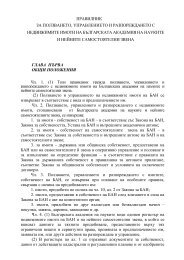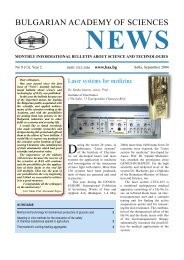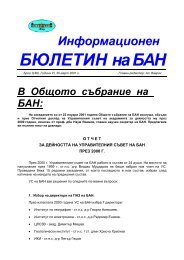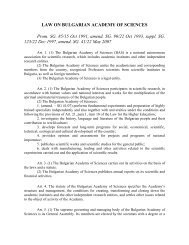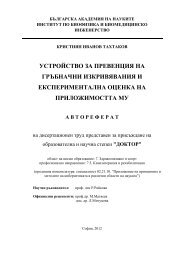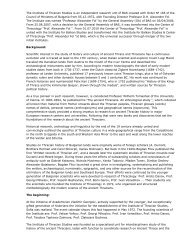Characterization of pulsed laser deposited chalcogenide thin layers ...
Characterization of pulsed laser deposited chalcogenide thin layers ...
Characterization of pulsed laser deposited chalcogenide thin layers ...
You also want an ePaper? Increase the reach of your titles
YUMPU automatically turns print PDFs into web optimized ePapers that Google loves.
Applied Surface Science 255 (2009) 5318–5321Contents lists available at ScienceDirectApplied Surface Sciencejournal homepage: www.elsevier.com/locate/apsusc<strong>Characterization</strong> <strong>of</strong> <strong>pulsed</strong> <strong>laser</strong> <strong>deposited</strong> <strong>chalcogenide</strong> <strong>thin</strong> <strong>layers</strong>T. Petkova a, *, C. Popov b , T. Hineva c , P. Petkov c , G. Socol d , E. Axente d , C.N. Mihailescu d ,I.N. Mihailescu d , J.P. Reithmaier ba Institute <strong>of</strong> Electrochemistry and Energy Systems (IEES), Bulgarian Academy <strong>of</strong> Sciences, S<strong>of</strong>ia, Bulgariab Institute <strong>of</strong> Nanostructure Technologies and Analytics (INA), University <strong>of</strong> Kassel, Germanyc Laboratory <strong>of</strong> Thin Film Technology, Department <strong>of</strong> Physics, University <strong>of</strong> Chemical Technology and Metallurgy, S<strong>of</strong>ia, Bulgariad National Institute for Lasers, Plasma, and Radiation Physics, Bucharest-Magurele, RomaniaARTICLEINFOABSTRACTArticle history:Available online 9 August 2008Keywords:Chalcogenide <strong>thin</strong> filmsPulsed <strong>laser</strong> depositionMorphologyNanostructureIn this work we report on <strong>pulsed</strong> <strong>laser</strong> deposition (PLD) <strong>of</strong> <strong>chalcogenide</strong> <strong>thin</strong> films from the systems(AsSe) 100 x AgI x and (AsSe) 100 x Ag x for sensing applications. A KrF* excimer <strong>laser</strong> (l = 248 nm;t FWHM = 25 ns) was used to ablate the targets that had been prepared from the synthesised <strong>chalcogenide</strong>materials. The films were <strong>deposited</strong> in either vacuum (4 10 4 Pa) or argon (5 Pa) on silicon and glasssubstrates kept at room temperature. The basic properties <strong>of</strong> the films, including their morphology,topography, structure, and composition were characterised by complementary techniques. Investigationsby X-ray diffraction (XRD) confirmed the amorphous nature <strong>of</strong> the films, as no strong diffractionreflections were found. The film composition was studied by energy dispersive X-ray (EDX) spectroscopy.The morphology <strong>of</strong> the films investigated by scanning electron microscopy (SEM), revealed a particulatecoveredhomogeneous surface, typical <strong>of</strong> PLD. Topographical analyses by atomic force microscopy (AFM)showed that the particulate size was slightly larger in Ar than in vacuum. The uniform surface areas wererather smooth, with root mean square (rms) roughness increasing up to several nanometers with the AgIor Ag doping. Based upon the results from the comprehensive investigation <strong>of</strong> the basic properties <strong>of</strong> the<strong>chalcogenide</strong> films prepared by PLD and their dependence on the process parameters, samples withappropriate sorption properties can be selected for possible applications in cantilever gas sensors.ß 2008 Elsevier B.V. All rights reserved.1. IntroductionThe <strong>chalcogenide</strong> glasses have recently focused significantscientific interest for the investigation <strong>of</strong> their basic properties andthe possibility for applications in optics and optoelectronics,electrochemistry, sensor technique, etc. The main attention paid tothese materials relies upon their large optical transmission rangeextending in the mid-infrared and covering usually the twoatmospheric windows lying from 3 to 5 mm and from 8 to 12 mm.One can find in literature many reports on the implementation <strong>of</strong><strong>thin</strong> <strong>chalcogenide</strong> <strong>layers</strong> in far infrared optics [1,2]. Chalcogenideglasses containing silver or silver salts are well known as superionicconducting glasses. Their conduction mechanism as well astheir application in solid state electrochemical devices is currentlysubjects <strong>of</strong> extensive studies [3]. Till now only few papers havereported on chemical sensors based on <strong>chalcogenide</strong> glassymaterials in the form <strong>of</strong> membranes [4] or <strong>thin</strong> films [5,6], butthey revealed their potential for application in sensors. As major* Corresponding author.E-mail address: tpetkova@bas.bg (T. Petkova).advantages <strong>of</strong> these amorphous inorganic materials we emphasizethat they can be easily prepared in bulk or layered forms by variousmethods. They also possess high chemical stability and can easilychange properties by small variations in composition due totheir disordered amorphous structure. We mention that all thesefeatures are common requirements for materials applied in gassensors.Among the deposition methods used for fabrication <strong>of</strong> <strong>chalcogenide</strong><strong>thin</strong> films, the vacuum thermal evaporation, DC/RF magnetronsputtering, and spin-coating technique stand presently forthe most common choice [7,8]. However, the deposition <strong>of</strong> multicomponent<strong>thin</strong> films with a desired degree <strong>of</strong> stoichiometry,acceptable homogeneity and good adhesion to the substrate stillremains a difficult task. One <strong>of</strong> the most promising and prospectivealternatives for preparation <strong>of</strong> such coatings is <strong>pulsed</strong> <strong>laser</strong>deposition (PLD). The proven advantages <strong>of</strong> PLD are among others:versatility, congruent transfer <strong>of</strong> target material to <strong>deposited</strong> films,ultimate purity <strong>of</strong> synthesised structures due to the use <strong>of</strong> lightpulses for ablation, easy control <strong>of</strong> the entire process and possibilityto deposit complex molecules and multistructures [9,10].The main goals with the current work were the PLD synthesis<strong>of</strong> <strong>thin</strong> films from the system As–Se doped with AgI or Ag and the0169-4332/$ – see front matter ß 2008 Elsevier B.V. All rights reserved.doi:10.1016/j.apsusc.2008.07.194
T. Petkova et al. / Applied Surface Science 255 (2009) 5318–5321 5319comprehensive investigation <strong>of</strong> the dependence <strong>of</strong> film propertieson process parameters in view <strong>of</strong> selecting chemical sensingsamples for further study with respect to their sorption properties.2. ExperimentalThe bulk materials with compositions (AsSe) 100 x AgI x and(AsSe) 100 x Ag x have been prepared by two-stage synthesis: (i)preparation <strong>of</strong> binary AsSe compound from elemental As and Sewith 5N purity; (ii) synthesis <strong>of</strong> quasi binary alloys AsSe–AgI orAsSe–Ag from previously obtained AsSe and commercial AgI or Ag(Alfa Aesar). Similar preparation procedures were applied forboth producing steps, namely the initial materials in respectiveamounts were placed in quartz ampoules evacuated down to10 3 Pa, further subjected to regular increase <strong>of</strong> the temperaturein a rotary furnace. The temperature was kept constant at themelting point <strong>of</strong> each component; the melt was continuouslystirred for better homogenisation. The glasses were obtained byquenching in a mixture <strong>of</strong> ice and water [11].The PLD targets were next prepared from the synthesisedglasses by milling, pressing and sintering. The deposition <strong>of</strong> <strong>thin</strong>(AsSe) 100 x AgI x and (AsSe) 100 x Ag x films was conducted byablation <strong>of</strong> the targets from the respective bulk materials with aKrF* excimer <strong>laser</strong> source (l = 248 nm, t FWHM = 25 ns). Theincidence fluence was set at 6.6 J/cm 2 , for deposition <strong>of</strong> each filmwe applied 3000 <strong>laser</strong> pulses. The films were <strong>deposited</strong> in eithervacuum (4 10 4 Pa) or argon at a dynamic pressure <strong>of</strong> 5 Pa onsilicon or glass substrates, kept at room temperature and placedparallel 5 cm from the target.After deposition, the films were characterised with respect totheir structure, composition, morphology, growth rate andtopography in order to investigate the influence <strong>of</strong> the processparameters and glass composition on their behaviours. Thestructure was studied by X-ray diffraction (XRD) with a DRONUM1 diffractometer using Cu K a excitation radiation. We workedin a u–2u configuration wi<strong>thin</strong> the range 20–658 and with a step<strong>of</strong> 0.058 and acquisition time 2 s. Energy dispersive X-ray (EDX)analysis <strong>of</strong> the film composition was achieved with a scanningelectron microscope (SEM, JEOL JSM-840A) equippedwithaLinkAnalytical Spectrometer (AN10000) (operated at an acceleratingvoltage <strong>of</strong> 20 kV). As a rule, the analysis was carried out at fourpoints for each sample. The oxygen content inside films wasmonitored by wavelength dispersive spectroscopy (WDS) usingan accelerated voltage <strong>of</strong> 10 kV, a beam current <strong>of</strong> 300 nA, LDEW-Si multilayer pseudo crystal and ZrO 2 as the standard.Scanning electron microscopy (SEM) investigations was donewith a Hitachi S4000 apparatus in order to study the filmmorphology. From SEM cross-section (XSEM) micrographs weevaluated the film thickness. The surface topography <strong>of</strong> the filmswas studied by atomic force microscopy (AFM, NanoScope II) ina tapping mode. The obtained images were analysed with theGwyddion s<strong>of</strong>tware.3. Results and discussionThe amorphous nature <strong>of</strong> the (AsSe) 100 x AgI x and (AsSe) 100 x Ag xfilms has been evidenced by XRD studies. The diffraction patterns <strong>of</strong>the films from both series were very similar with broad halo andwithout sharp peaks belonging to crystalline phases <strong>of</strong> anycomponent <strong>of</strong> the film composition (Fig. 1). The films prepared inAr showed a higher halo background as compared to films <strong>deposited</strong>in vacuum. This feature is related to the role <strong>of</strong> the Ar ions asadditional transporters <strong>of</strong> the molecules. As known, the presence <strong>of</strong> alow-pressure ambient gas results in plasma confinement leading tothe deposition <strong>of</strong> thicker films [9,10].Fig. 1. Typical X-ray patterns <strong>of</strong> As–Se–AgI films prepared by PLD.The compositions <strong>of</strong> some <strong>of</strong> the films <strong>deposited</strong> in vacuumwere measured by EDX and are presented in Table 1. The resultsexhibit some peculiarities, namely: (i) in some cases deviationsfrom the unity ratio As–Se were found; (ii) loss <strong>of</strong> dopant (Ag orAgI) is observed and the higher the dopant concentration in thetarget materials, the bigger the differences in the film composition,including also the As–Se ratio, compared with the bulk samples.The deficiency <strong>of</strong> AgI or Ag in the film composition is most probablycaused by the difference in the enthalpy <strong>of</strong> deposition <strong>of</strong> theevaporated fragments. The dissociation <strong>of</strong> the target materialduring the <strong>laser</strong> ablation generates fragments (As–Se, silver, iodine,etc.) with various mass and velocity, which are transported to thesubstrate. The enthalpy <strong>of</strong> deposition is different for variousfragments and the quantity <strong>of</strong> each fragment <strong>deposited</strong> onto thesubstrate depends on it. No oxygen was detected in the films byWDS wi<strong>thin</strong> the accuracy <strong>of</strong> the method (1%).The top-view SEM pictures <strong>of</strong> films from both systemsrevealed the uniform and homogeneous character <strong>of</strong> theirsurfaces (Fig. 2). Neither defects (liquation) nor traces <strong>of</strong> initialnucleation were visible, while the presence only <strong>of</strong> somesubmicron-sized particulates is noticed. The existence <strong>of</strong>particulates <strong>of</strong> various shapes and dimensions is a well-knownphenomenon in PLD and various efficient techniques have beendeveloped in view <strong>of</strong> their control and elimination [12,13]. Wenote however that for the envisaged application <strong>of</strong> the As–Se–Ag(AgI) films as sensitive <strong>layers</strong> in gas chemical sensors thepresence <strong>of</strong> the particulates could be advantageous, sincethey increase the effective active surface for interaction withgaseous analytes. We determined the thickness <strong>of</strong> the films fromcross-section SEM micrographs. It was in all cases wi<strong>thin</strong> therange (450–900) nm (Table 1), corresponding to growth rates <strong>of</strong>(0.15–0.30) nm/pulse. The growth rate was (1.2–1.6) timesTable 1Deposition ambient, composition and thickness <strong>of</strong> As–Se–Ag(AgI) films synthesisedby PLDSampleTargetcompositionFilm composition(2 mol.%)AmbientB2-4 As 45 Se 45 (AgI) 10 As 42 Se 48 Ag 6 I 4 VacuumB2-5 Argon 850B7-4 As 35 Se 35 (AgI) 30 As 38 Se 46 Ag 4 I 12 Vacuum 550B7-5 Argon 900C1-2 As 45 Se 45 Ag 10 As 41 Se 51 Ag 8 Vacuum 750C1-3 Argon 900C3-4 As 40 Se 40 Ag 20 As 37 Se 52 Ag 11 Vacuum 450C3-3 Argon 650Thickness(nm)
5320T. Petkova et al. / Applied Surface Science 255 (2009) 5318–5321Fig. 2. Typical top-view SEM micrographs <strong>of</strong> PLD As–Se–Ag(AgI) films: (a) sample B2-4 and (b) sample C3-4 (see Table 1).Fig. 3. AFM images <strong>of</strong> PLD As–Se–Ag(AgI) films: (a) sample B7-4 and (b) sample C2-2 (see Table 1).higher for the films synthesised in Ar ambient in comparisonwith those grown in vacuum. This increase is a consequence <strong>of</strong>plasma confinement (as discussed above) which was clearlyvisible from the change <strong>of</strong> plasma expansion from ‘‘plumes’’ invacuum to a ‘‘cigar-like’’ shape in Ar [14].The AFM examination confirmed the results concerning the filmtopography obtained from the SEM study. The (AsSe) 100 x AgI x and(AsSe) 100 x Ag x films exhibited uniform and smooth surfaces withsome particulates, as discussed above (Fig. 3). The roughness <strong>of</strong> thefilms was next determined by analysis <strong>of</strong> the AFM images in areasfree <strong>of</strong> particulates. Fig. 4 shows the influence <strong>of</strong> the dopant (AgI orAg) concentration upon the rms roughness. The latter increasesrather linearly with the dopant concentration, a trend better visiblein the case <strong>of</strong> AgI. Generally, the roughness <strong>of</strong> the films grown invacuum was close for both types <strong>of</strong> dopants, while PLD in Arresulted in slightly rougher coatings when doping with Ag thanFig. 4. Influence <strong>of</strong> the dopant concentration on the rms roughness <strong>of</strong> PLD As–Se–Ag(AgI) films. The line is given as an eye guide.Fig. 5. Influence <strong>of</strong> the dopant concentration on the droplet size on PLD As–Se–Ag(AgI) films The lines for two series are drawn as eye guides.
T. Petkova et al. / Applied Surface Science 255 (2009) 5318–5321 5321with AgI. The distribution <strong>of</strong> the particulate size was also studied. Itwas found that the deposition <strong>of</strong> films with higher Ag concentrationleads to the formation <strong>of</strong> larger particulates, while thevariation <strong>of</strong> AgI content has only a marginal influence on theparticulate size (Fig. 5). The observed slight increase <strong>of</strong> theparticulate diameter for films <strong>deposited</strong> in Ar vs. those synthesisedin vacuum could be the result <strong>of</strong> collisions between ablatedsubstance and the Ar molecules [15,16]. These collisions maysignificantly slow-down the small particulates. As an effect, part <strong>of</strong>them will be eliminated due to gravitation, while some others willcluster in larger particulates by coalescence [9,15,16].4. ConclusionsThin (AsSe) 100 x AgI x and (AsSe) 100 x Ag x films were preparedby <strong>pulsed</strong> <strong>laser</strong> deposition from the respective bulk glasses.The amorphous nature <strong>of</strong> the target materials was preserved in the<strong>deposited</strong> films. Their compositions show losses <strong>of</strong> silver andiodine in comparison with the target materials, which are higher athigher dopant concentrations. In same cases a deviation <strong>of</strong> the As–Se ratio from unity was also found, which was stronger for a largerdoping with Ag or AgI. The PLD films exhibited homogeneoussurfaces covered with some particulates. The roughness <strong>of</strong> theparticulate-free areas was in the order <strong>of</strong> few nanometers. Theobserved topography could be beneficial for application <strong>of</strong> theobtained As–Se–AgI(Ag) coatings as sensitive <strong>layers</strong> in chemicalcantilever-based sensors, because <strong>of</strong> the increased active surfacefor interaction with gaseous analytes.AcknowledgementsThe authors gratefully acknowledge the financial support <strong>of</strong>NATO under the Collaborative Linkage Grant Program (CBP.EAP.CLG982793). They would also like to thank to Center <strong>of</strong> AdvancedMaterials, University <strong>of</strong> Pitesti, for the XRD analyses, and to Dr. V.Mikli (Center for Materials Research, Talin Technical University) forthe EDX and WDS studies. Romanian co-authors acknowledge thepartial support <strong>of</strong> this work by CNCSIS grant No. 872.References[1] A. Zakery, P.J.S. Ewen, C.W. Slinger, A. Zekak, A.E. Owen, J. Non-Cryst. Solids 137(1991) 1333.[2] C. Vigreux-Bercovici, E. Bonhomme, A. Pradel, J. Non-Cryst. Solids 353 (2007)1388.[3] E.R. Baranova, V. Kobelev, O. Kobeleva, L. Nugaeva, V. Zlokazov, L. Kobelev, SolidState Ionics 146 (2002) 415.[4] J.P. Kloock, Y.G. Mourzina, Y. Ermolenko, T. Doll, J. Schubert, M.J. Schöning, Sensors4 (2004) 156.[5] M. Frumar, B. Frumarova, P. Nemec, T. Wagner, J. Jedelsky, M. Hrdlicka, J. Non-Cryst. Solids 352 (2006) 544.[6] M. Popescu, F. Sava, A. Lorinczi, G. Socol, I.N. Mihailescu, A. Tomescu, C. Simion, J.Non-Cryst. Solids 353 (2007) 1865.[7] P. Nemec, J. Jedelsky, M. Frumar, M. Vlcek, J. Optoelect. Adv. Mater. 7 (2005)2635.[8] P. Nemec, M. Frumar, J. Jedelsky, M. Jelinek, J. Lancok, I. Gregora, J. Non-Cryst.Solids 293–302 (2002) 1013.[9] D.G. Chrisey, G.K. Hubler (Eds.), Pulsed Laser Deposition <strong>of</strong> Thin Films, Wiley, NewYork, 1994.[10] D. Bauerle, Laser Processing and Chemistry, 2nd ed., Springer, New York, 1996.[11] T. Hineva, T. Petkova, P. Petkov, V. Mikli, C.N. Mihailescu, I.N. Mihailescu, J. Phys.,Conf. Ser. 113 (2008) 012023.[12] I.N. Mihailescu, E. Gyorgy, V.S. Teodorescu, Gy. Steinbrecker, J. Neamtu, A.Perrone, A. Luches, J. Appl. Phys. 86 (12) (1999) 7123.[13] I.N. Mihailescu, V.S. Teodorescu, E. Gyorgy, A. Luches, A. Perrone, M. Martino, J.Phys. D: Appl. Phys. 31 (1998) 2236.[14] M. Stoica, I.N. Mihailescu, Al. Hening, I. Ursu, A.M. Prokhorov, P.I. Nikitin, V.I.Konov, A.S. Silenok, J. Appl. Phys. 66 (11) (1989) 5204.[15] A. Luches, G. Leggieri, M. Martino, A. Perrone, G. Majni, P. Mengucci, I.N. Mihailescu,Thin Solid Films 258 (1995) 40.[16] I.N. Mihailescu, V.S. Teodorescu, E. Gyorgy, C. Ristoscu, R. Cristescu, SPIE Proceedings<strong>of</strong> the International Conference <strong>of</strong> ALT‘01, vol. 4762, September 11–14, 2001,(2002), p. 64.



